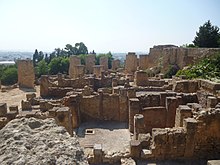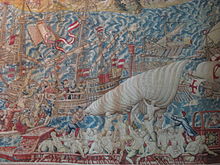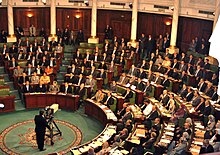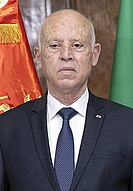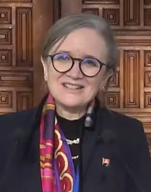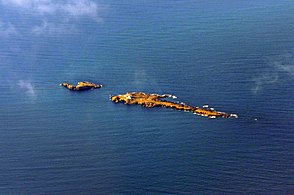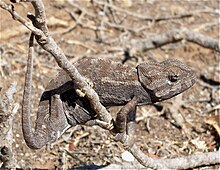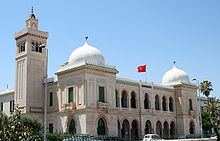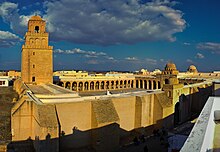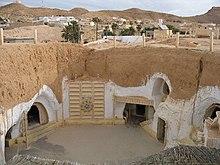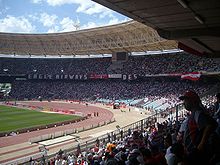Tunisia
Tunisia(in Arabic, تونس ![]() Tūnisin Berber, Tunestin French, Tunisie), whose official name is Tunisian Republic (in Arabic, الجمهورية التونسية, romanized:el-Jomhūriya it-Tūnisiyain French, République tunisienne), it is a sovereign country located in North Africa, more specifically on the Mediterranean coast. Its form of government is the semi-presiding republic. Its territory is organized in 24 governorates or wilayat. The capital is Tunisia, the most populous city, which gives the name to the country.
Tūnisin Berber, Tunestin French, Tunisie), whose official name is Tunisian Republic (in Arabic, الجمهورية التونسية, romanized:el-Jomhūriya it-Tūnisiyain French, République tunisienne), it is a sovereign country located in North Africa, more specifically on the Mediterranean coast. Its form of government is the semi-presiding republic. Its territory is organized in 24 governorates or wilayat. The capital is Tunisia, the most populous city, which gives the name to the country.
It is the smallest country in the Maghreb, located between the eastern foothills of the Atlas Mountains and the Mediterranean Sea. The surface of Tunisia is 163,610 km², with an estimated population of 11.8 million inhabitants. Approximately 40% of this country is made up of the Sahara desert, while the rest is fertile soil suitable for agriculture; It also has 1,148 km of coastline. It is bordered by Algeria to the west, Libya to the southeast, and the Mediterranean Sea to the east and north.
In ancient times, Tunisia was inhabited mainly by Berbers. Phoenician immigration began in the XII B.C. These immigrants founded Carthage, a major trading power and military rival to the Roman Republic. Carthage was defeated by the Romans in 146 B.C. C. The Romans, who occupied Tunisia for most of the next eight hundred years, introduced Christianity and left architectural legacies such as the El Djem amphitheatre. After several attempts beginning in 647, the Muslims conquered the whole of Tunisia by 697, followed by the Ottoman Empire between 1534 and 1574. The Ottomans held sway over the territory for more than three hundred years, until, during their decline in the XIX, France established a protectorate over the country in 1881. In 1956, the country became independent as a constitutional monarchy, which was overthrown in the next year. The leader of the Neo-Destour party, Habib Bourguiba, declared the Republic and remained president until his overthrow in 1987, being replaced by Zine El Abidine Ben Ali of the Democratic Constitutional Rally party. Ben Ali despotically ruled the country until he resigned on January 14, 2011 in the midst of what became known as the Tunisian revolution, a large-scale social uprising that culminated in the call for free legislative elections and the drafting of a new constitution, that governs the country since 2014. That same year, the first presidential and legislative elections were held under it.
Under the current constitution, Tunisia is a unitary, semi-presidential republic that adopts representative democracy as its form of government. Tunisia is considered by various human rights organizations as the only truly democratic country in the Arab World. It is also awarded one of the highest human development indices in Africa. It has association agreements with the European Union, is a member of La Francophonie, the Union of the Mediterranean, the Arab League, the Arab Maghreb Union, the Organization for Islamic Cooperation, the Greater Arab Free Trade Zone, the Community of Sahel-Sahara States, the African Union, the Movement of Countries Non-Aligned, From the Group of 77; and has obtained the status of a major non-NATO ally. Furthermore, Tunisia is a member state of the United Nations and the Rome Statute of the International Criminal Court. Close relations with Europe, in particular with France and with Italy, have been forged through economic cooperation, privatization and industrial modernisation.
Name
The word "Tunisia" derives from Tunis, known to the classical Greeks as Tynes, the capital of the present-day country of Tunisia. The name Tunis can be attributed to various origins. It may be associated with the Phoenician deity Tanith (or Tunit), or with the Berber expression ens which means "to fall".
As in English, in the native Arabic, the same name is used for both the country and the city: تونس , and only by context can one tell them apart. To this end, French geographers and historians at the beginning of the XIX century adopted the word "Tunisie" to designate the country, as part of his efforts to give names to the newly occupied territories and protectorates. Most European languages followed suit, but in Spanish the "Tunisia" version did not catch on.
History
From Punic Carthage to Roman Carthage
In the territory of present-day Tunisia, the city of Carthage flourished, founded in the VIII century BC. C. by the Phoenicians of Tyre. Around the VI century BC. C., Carthage had subjugated the Libyan tribes and annexed the former Phoenician colonies, thus controlling the entire North African coast, from the Atlantic Ocean to the western border of Egypt, as well as Sardinia, Malta, the Balearic Islands and part of Sicily. In the V century a. C., the Carthaginian navigator Hanno (530-470 B.C.) set out on a voyage along the Atlantic coast of North Africa. Sea power allowed the Carthaginians to extend their settlements and conquests, forming a scattered empire dedicated to trade. His business ventures included silver and lead mining, bedding manufacturing, a logging industry in the Atlas Mountains, pottery manufacturing, jewelry, and the export of wild animals from the African jungles, ivory and the gold. Carthage was at war almost continuously with Greece and Rome for 150 years. The wars with the Greeks, which began in 409 B.C. C., were produced by the domain of Sicily, located approximately 160 km north of Carthage, which formed a natural bridge between North Africa and the Italian peninsula.
It was definitively conquered by the Roman Republic when it was defeated in the Punic Wars in the 2nd century BC. C. Carthage was destroyed and the Asian and African cultural influence in present-day Tunisia was diminished by the Roman influence. The territory of modern Tunisia was administered almost entirely under the name of the Roman province of Africa, and became one of the granaries of Rome.
Middle Ages
In the 5th century century, Vandals led by Gaiseric invaded the region. In VI, Belisarius reclaimed it for the Byzantine Empire. In the 7th century it became part of the Umayyad and Abbasid Caliphate, under the name of Ifriqiya. During this time the city of Kairouan was founded. Subsequently, the native Berbers rose to power with the blessing of the Fatimid Caliphate, and the Aghlabid dynasty was overthrown and the Zirid dynasty replaced. In 1045, the Zirids renounced Shiism, and the Fatimids sent the Banu Hilal, a Bedouin confederation, to wipe out the Zirids. In this way, the region was devastated and the thriving agricultural industry was ruined.
In 1159, the Almohads dominated the region, being driven out in the 13th century by the Hafsids, who ruled Ifriqiya. There he took refuge and died Louis IX of France when he was on his way to the crusades.
Ottoman Tunisia
The end of the Spanish Reconquest in 1492 opened the doors of North Africa to this country. In 1504 the Barbary privateer Uruj, known as Barbarossa, established his headquarters in Tunis. This famous pirate was born on a Greek island in the Aegean Sea. One of his first feats was the capture of two galleys owned by Pope Julius II loaded with riches. Barbarossa paid tribute to the so-called "Sublime Gate" (Turkey), offering her a quarter of his catch and declaring himself a vassal of his sultan.
Tunisia soon became a haven for Barbary pirates, staunch enemies of the Christians of the Mediterranean. The continuous depredations of the Tunisians motivated in 1509 the expeditions organized by Cardinal Cisneros, who advanced the necessary funds to equip 20,000 men. Cisneros entered the city of Orán with his troops, and Pedro Navarro subdued Bugía, Algiers, Tunis, Tlemcen and in the year 1511 the city of Tripoli. But when trying to subdue the island of Gelbes, the Spanish forces, exhausted, were attacked by the Moors. The few survivors of the battle were re-embarked by General Navarro, being able to escape death.
In 1516, Barbarossa moved his headquarters to Jijil, and commanding a squadron of 16 galleons and 6,000 men, attacked the Spanish citadel of Algiers. His adventures in the region ended when Emperor Charles I of Spain sent an army of 10,000 soldiers to North Africa that defeated the corsairs. The famous corsair Barbarossa was killed during the battle, but the entire region continued under the power of the Moors and pirates. For this reason in 1535 the King of Spain Carlos I left for Tunis with all his forces. The Goleta was taken on July 16, and Tunis fell a few days later. Carlos I replaced Muley Hassan on the throne, forcing him to leave La Goleta with two miles of land in circumference. When the Spanish king set out to conquer Algiers in 1541, storms destroyed a large number of his ships.
In 1573, Tunisia again fell into the hands of the Turks, being the object of a new Spanish expedition. On October 1, Juan de Austria, after the victory at Lepanto, went to La Goleta with 104 ships and 20,000 men and conquered Tunisia. But a year later Tunis fell into the hands of the Turks again, becoming a vilayate administered by a governor. Under the long Ottoman rule, the country experienced a period of relative stability until 1881.
Imperial administration was developed by native administrators, known as beys. The first of them, al-Husayn ibn Ali (1705-1740) founded the Husáin dynasty, consolidating the Beylicate of Tunisia; under his rule the country achieved a relative degree of autonomy and great prosperity. Barbary piracy was an activity that flourished under the auspices of the Husáin dynasty. Late 17th century and early XVIII, a large number of Mediterranean states regularly paid tribute to the Tunisian government to protect their fleets from possible attacks. This situation changed at the beginning of the XIX century, when the joint action of several Western countries wiped out the privateer bases in Tunisia and other located along the so-called Barbary coast, on the north coast of Africa. As a result of the loss of revenue from acts of piracy, the Tunisian government was embroiled in huge debts, contributed to by the beys' uncontrolled personal extravagances and spending to quell frequent internal riots.
French rule
At the end of the 18th century Ottoman authority over Tunis was merely nominal. Tunisia's main creditors were France and Great Britain, both of whom had great imperial ambitions in North Africa. In 1830, France conquered and annexed Algeria and set its sights on Tunisia. At the Congress of Berlin in 1878, France allowed Great Britain to occupy the Mediterranean island of Cyprus in exchange for seeing her interests in Tunisia recognized. In 1881 the French army occupied the country in order to subjugate the tribes that made the French presence in Algeria difficult; On May 12 of that same year, the regent signed the Treaty of Kasser Said (known as the "Bardo Treaty", rejected by Italy since there was a large colony of Italians in Tunisia), by which Tunisia became a French protectorate. In 1883 both countries signed the Marsa Convention.
During World War II, Tunisia was one of the French colonies loyal to the pro-German Vichy regime; Consequently, Italian and German troops settled in their territory, where they ended up cornered by the Allies. After the end of the war, Tunisia continued under the colonial control of France until it achieved its independence in 1956.
Independence
The year 1934, with the formation of the Neo-Destour (New Constitution) Party (NDP) led by Habib Bourguiba, marked the beginning of the Tunisian struggle for its independence. In 1955 Tunisia achieved self-government and, in 1956, independence as a constitutional monarchy. In 1957, the monarchy was overthrown and the Republic was proclaimed, with Bourguiba as President.
Autocracies
Despite independence, France maintained its military presence through a naval base in Bizerte until 1963. In that year, following a blockade by the Tunisian navy, the French were forced to leave the country for good. This policy of distancing from the old colonial power took a new step on May 12, 1964 when, by surprise, the lands of foreign settlers were expropriated. France and Italy, countries whose nationals were the most affected, protested and suspended economic aid.
The government of the Desturian Socialist Party (renamed the Rassemblement Constitutionel Démocratique in 1988), coexisted with the NDP and forced Bourguiba to pursue socialist policies in the early years of his term. However, during the 1970s he opened the economy to foreign investment and allowed the development of the private sector.
Since his successful coup in 1987, President Zine El Abidine Ben Ali has held power with the help of his Democratic Constitutional Rally (RCD) party. Although formally multiparty, the political regime was internationally regarded as dictatorial, and opposition political parties had little access to parliament.
Its foreign policy was characterized by its support and hosting of the Palestinian Liberation Organization fighters since their forced departure from Lebanon following the Israeli invasion in 1982. Tunisia was also one of the of the driving countries of the Maghreb Arab Union, established in February 1989, conceived as a political and economic bloc in North Africa, parallel to the European Community, comprising Algeria, Libya, Morocco, Mauritania and Tunisia. Tunisia belongs to various international cooperation organizations, such as the League of Arab States, the African Union (AU) and the Community of Sahrawi-Saharan States.
In 2001 the European Union signed agreements with Tunisia to control clandestine emigration, which would materialize in the 5+5 Group in 2002 (Portugal, Spain, France, Italy, Malta and Mauritania, Morocco, Algeria, Tunisia and Libya). A terrorist group linked to Al-Qaeda carried out an attack on April 11, 2002 in a synagogue on the island of Djerba, killing 15 people.
Revolution and democracy
Between the end of 2010 and the beginning of 2011, a series of protests and riots took place that forced President Zine El Abidine Ben Ali to call elections for 2014. Later, on the afternoon of January 14 of the same year, before the Continuing the protests, he left the country, fleeing to Saudi Arabia and leaving power to Prime Minister Mohammed Ghannouchi, who in turn was replaced the next day by Parliament Speaker Fouad Mebazaa.
On October 23, 2011, free elections to a Constituent Assembly were held after the main opposition political parties were legalized and the former ruling party outlawed. The vote gave rise to a very fragmented assembly in which the Islamist party Ennahda stands out, followed by the secular parties Congress for the Republic (progressive), Ettakatol (social democrat) and Republican Party (centrist, the result of the merger of the Democratic Progressive Party with other minor forces). The assembly elected Mustafa Benjaafar, from Ettakatol, as its president. On December 10, 2011, the assembly adopted a provisional constitution and, two days later, elected the leader of the Congress for the Republic, Moncef Marzouki, as the provisional president of the Republic. Marzouki nominated Hamadi Jebali, Ennahda's general secretary, as prime minister, who was ratified by the assembly and formed an interim coalition government between the three main parties. The Constituent Assembly continued with its work to approve a new Constitution through complex negotiations.
On Wednesday, February 6, 2013, the secular and left-wing leader Chokri Belaid was assassinated in front of his home in Tunis. At the funeral held two days later, the secular political forces made a show of force by demonstrating and holding a 24-hour general strike called by the General Union of Tunisian Workers (UGTT), the most important union in the country, calling for the resignation of the Tunisian government. moderate Islamist Hamadi Jebali. These events revealed the polarization and growing confrontation that Tunisia was experiencing between Islamists and secularists, and which explained why the Constituent Assembly elected at the end of 2011 had not yet managed to approve the new Constitution. The Islamist response was swift and after the burial a group of "bearded men" - as the most radical Islamists are known - attacked Najib Chebbi, leader of the Progressive Democratic Party, shouting "Enemy of God!" and the next day, Saturday February 9, 2013, the youth of the government Ennahda party held a demonstration in defense of the "legitimacy" of the power held by their party - it obtained 40% of the seats in the 2011 elections - and against “French interference” — they shouted “France get out! France, enough is enough!"—referring to statements by French Interior Minister Manuel Valls who, after condemning the assassination of Tunisian secular oppositionist Chokri Belaid, lamented "the widespread rise of Islamic fascism," which also prompted official government protest Tunisian who described the statement as "unfriendly".
As the analyst for the Spanish newspaper El País Ignacio Cembrero has pointed out, "the process is similar to that experienced by Egypt. If in this country the Islamist current - the Muslim Brotherhood and the Salafists - is in the majority, except perhaps in large cities like Cairo, in Tunisia both forces are quite balanced. Hence, the future of the country sometimes described as the laboratory of democracy in the Arab world is unknown. Belaid was not the first layman to be murdered. In October 2012 Lofti Nagdh, coordinator in Tataouine of the secular Nidá Tunis party, was lynched by exalted groups who have not yet been arrested. The two main protagonists of Islamist violence are the Salafists and the League for the Protection of Revolution, which the opposition links to the ruling Ennahda party.
The final text of the new Constitution was approved on January 26, 2014 by the Constituent Assembly with 200 votes in favor, 12 against and 4 abstentions. The following day, the text was signed by the president, Moncef Marzouki, president of the Constituent Assembly, Mustapha Ben Jaafar, and the head of the outgoing government, Ali Larayedh, during a ceremony at the venue of the meetings.
On July 10, 2015, Tunisia is designated by the US as a principal non-NATO ally, a special status shared by sixteen countries and which opens the door to the delivery of surplus items defense and the organization of joint training. The countries that already have this designation are: Afghanistan, Argentina, Bahrain, Egypt, Israel, Japan, Jordan, Kuwait, Morocco, New Zealand, Pakistan, the Philippines, Thailand and the Republic of Korea.
Government and politics
President from 2019
Prime Minister since 2021
Under the constitution of 26 January 2014, Tunisia is a republic with a semi-presidential system of government, based on representative democracy. Under this system, the president of the republic is the head of state, directly elected by popular vote for a five-year term with the possibility of a single re-election, while the cabinet is chaired by a Head of Government appointed by the legislature. Although the country proclaims freedom of worship, the official religion is Islam and it is a constitutional obligation that the president be a Muslim. The unicameral Assembly of People's Representatives is the country's legislative body, charged with approving legislation and ratifying the cabinet and prime minister. The assembly has 217 seats elected by proportional representation by lists for a term of no more than five years. Since the 2014 legislative elections, with 68 women elected, the Tunisian parliament is the legislature with the highest percentage of female representation in the Arab World.
The Tunisian legal system is heavily influenced by French civil law, while personal status law is based on Islamic law. Sharia courts were abolished with independence, in 1956. A Status Code Personal was adopted shortly after independence in 1956, which, among other things, gave women full legal status (allowing them to run their own companies, hold bank accounts, and seek passports on their own authority). The code prohibited practices of polygamy and repudiation and the right of a husband to unilaterally divorce his wife. Other reforms in 1993 included a provision to allow Tunisian women to transmit citizenship, even if they are married to a foreigner and live in abroad. The Personal Status Law applies to all Tunisians regardless of their religion. The Personal Status Code remains one of the most progressive civil codes in North Africa and the Muslim world.
In Tunisia the number of political parties has increased considerably since the revolution, exceeding 100 to date, although most already existed before the overthrow of Ben Ali and were simply legalized afterwards. Tunisia is included in the Political European Neighborhood Partnership (ENP) of the European Union, which aims to bring the EU and its neighbors closer together.
Geography
The capital of Tunisia is the city of the same name, Tunis, and is located at the following map coordinates: 36° 50' N 10° 9' E. Tunisia is located in North Africa, between the Mediterranean Sea and the Sahara desert, and between Algeria and Libya. About 40% of the surface of its territory is desert, the other part is made up of fertile land.
In the north, there are mountains and the climate is temperate, with mild, rainy winters and hot, dry summers. The range of temperatures in the north is between 34 and 6 °C. In the south, there are deserts that extend to the Sahara. However, despite its aridity in the south, in the north there are pine forests, and meadows ideal for cattle, in the northeast, as well as orchards and vineyards along the eastern coast.
Only 19% of the land is arable, although 13% is irrigated (est. 1993). Tunisia is the smallest country of the Northwest African States and ranks number 89 on the list of countries on the planet by size. It has a total area of 163,610 km². Of this area, 155,360 km², that is, 94.5% of the total area, are land. The rest, 8,250 km², 5.5%, are land surfaces. water.
The highest point in Tunisia is Mount Jebel Chambi, north of the city of Kasserine, and is 1,544 m a.s.l. no. m.. The surface of the mount is covered with pines.
Tunisia has 1,034 km of borders with Algeria and 461 km of borders with Libya. In addition, it has a coastline of 1,148 km in length. However, its coastline is dotted with small islands. Between the island of Sicily and Tunisia there is a distance of only 130 km.
Elephants, immortalized by Hannibal using them in his battles, have become extinct in Tunisia. The lions also disappeared centuries ago, used by the Romans in their shows. French settlers nearly drove the Barbary deer and some species of gazelle to extinction. In the north, wild boars, mongooses, porcupines and genets can be found in the forests. Ostriches, wild goats and antelopes are protected in the Bou Hedma national park. In the desert you can find the elusive fennec, as well as scorpions and horned vipers. A species of monitor lizard also inhabits the desert. The Ichkeul National Park is a wildlife refuge near the capital, where waterfowl live. Migratory birds, hawks, storks, and eagles, arrive in spring and fall.
- Some of Tunisia's diverse geographical
Natural borders
Tunisia can be divided from north to south into several easily distinguished topographical regions. Starting from the north and going south, first there is a series of mountain ranges, including the Atlas Mountains, in the so-called Tell region, which occupy the northern half of the country and cross Tunisian territory from the south. southwest to northeast, with elevations ranging from 610 to 1,544 m a.s.l. no. m., reaching the highest point of this mountain range, the so-called Jebel de Ech Chambi, which in turn is the highest point in Tunisia.
In these territories, the fertile valleys and the plateaus meet the mountains. It is in this area where the longest river in Tunisia, the Majardah or Meyerda, is born, 460 km long, which crosses the area from west to east and then reaches the Gulf of Tunis, where it flows.
To the south, the landscape changes from mountains to a plateau with a height of 610 m. no. m. average. These plateaus gradually descend to an area formed by salt lakes, known as shatts or chotts, which extend from east to west and are mostly at sea level. Among these lakes we can highlight the Djerid and the Bizerta. This area is characterized by its semi-desert steppe nature.
In the southernmost area, the Shatts join the Sahara desert, which occupies 40% of the total land area of Tunisia. In the area between the shatts and the Sahara desert there are numerous oases; especially in the vicinity of the city of Gabes, located in the center of the homonymous Gulf of Gabes that receives the same name, in the area closest to the border with Libya. In this region, vast oases abound, with nearly 400,000 date palms growing there. The oases are also used as fields for cultivation; these crops partly reach the coast.
To the north, Tunisia borders Algeria and describes a border that is defined by the irregularities of the terrain in the Atlas Mountains, with the exception of the northernmost area in which the border is defined by the Algerian natural park of The Kala. These natural limes follow one another along the entire length of the mountainous system that crosses Tunisia, but when this system descends and the Sahara desert appears, more specifically, the Grand Erg Oriental, the border with Algeria becomes a simple straight line, since it does not there is no geographical feature in that territory capable of forming a border.
The border with Libya is marked mainly by the highlands of the Libyan region of Tripolitania. It can be seen that all the natural borders of Tunisia are delimited by plateaus and mountains, which is due to the fact that in Tunisia rivers are almost non-existent.
Relief
Tunisian relief is based on the Tellian Atlas in the north and the Atlas Mountains in the center of the country. In the south of Tunisia, a semi-desert steppe stretches out and later becomes the Sahara desert.
The highest point in the country, Djebel Chambi, is located in its center, in the Atlas Mountains, and measures 1544 m s. no. m. Tall. Around this peak extends the natural park of Jebel Chambi. In turn, the lowest point is Shatt Al Gharsah, in the southwest of the country, on the border with Algeria, and is 17 m below sea level. Very close to this shatt is the Shatt El Jerid, the largest in Tunisia.
Between the cities of Bizerte and Tabarka is an extension of the Atlas called the Dorsale mountain range, where cultivated fields abound. This region produces most of the country's food and exports many types of crops, such as olives or citrus. In the relief of central and northern Tunisia, the large mountainous regions of the Atlas Mountains alternate with the depressions generated by some rivers or the shatts.
Tunisia has many natural parks among its mountains, such as Jebel Chambi, where the highest point in the country is located, Jebel Bu Hedma, Ichkeul National Park or Bu Kornine Park.
In the south, the Gran Erg Oriental extends, where the flatness of the terrain stands out due to the fact that it is a desert. The populations of Tozeur, Douz and Medenin stand out. In this region, biodiversity is scarce and the majority of the population is of Berber origin, in ancient times nomads, but currently, the majority are settled and have founded cities and towns such as Matmata. Tuaregs also inhabit this area, although most of them have disappeared. In this area there are few cities and communication routes.
Ecology
According to WWF, the territory of Tunisia is divided into five ecoregions:
- North African mountain forest in the northwest mountains.
- North African Mediterranean forest on the coast and the northern half of the country.
- Mediterranean arbustive steppe in the center.
- North Sahara steppe in the south half.
- Salobral of the Sahara in several wetlands in the center and north of the country.
Ichkeul Park, which covers more than 12,600 ha, is inscribed on the UNESCO World Heritage List. There are also 16 natural reserves that are home to many species with important ecological value and vulnerable ecosystems.
According to a study by the WWF's Mediterranean program, the northwest coast region would be one of the 13 Mediterranean sites with the greatest diversity of animals and plants.
Political-administrative organization
Tunisia is divided into 24 governorates or wilayāt.
- Ariana
- Béja
- Ben Arous
- Bizerta
- Gabes
- Gafsa
- Jendou
- Kairouan
- Kasserine
- Kebili
- Kef
- Mahday
- Manouba
- Medenine
- Monastir
- Nabeul
- Sfax
- Sidi Bou Said
- Siliana
- Susa
- Tataouine
- Tozeur
- Tunisia
- Zaghouan
Tunisia belongs to various international cooperation organizations such as the League of Arab States, the African Union (AU) and the Community of Saharawi-Saharan States (CEN-SAD).
Economy
In ancient times, as a consequence of the fragile economy of the country, the circulation of foreign currencies was allowed throughout the territory. To do this, King Muhammad III ibn al Husayn (1293-1299 hijra) used a countermark containing numbers in Arabic and a star. This mark was stamped on silver coins of 8 Spanish reales, 5 Napoleon francs and talers of Queen Maria Teresa I of Austria. There are also some countermarks with the word "TUNISIA" in Arabic.
Tunisia has a diverse economy, where the most important sectors are agriculture, mining, energy, tourism, oil and manufacturing companies. Tunisia lacks the immense natural resources of neighboring countries, but careful and successful economic management has brought reasonable prosperity. The main agricultural products are wheat, barley, olive oil and fruits, but they need to import large amounts of other foodstuffs, particularly in years of drought that have been frequent in recent years. Arable land represents 4.9 million hectares, of which 1.6 are devoted to cereals, another 1.6 to olive groves and 0.4 to irrigated fields.
It has phosphate, iron and zinc mines. Tunisia is a modest oil exporter. The industrial sector processes the phosphate mine and works with chemical products derived from petroleum. The recent falls in the price of oil and phosphates have forced the Government to submit to the economic guidelines of the IMF, accepting certain reforms in exchange for soft loans. According to the British Philip's University Atlas from 2000, Tunisia has a phosphate reserve in the central part of the country. The Government has cut public spending, abolished control of trade and introduced measures to make the dinar fully convertible.
Starting in the 1970s, positioned in sectors where its competitiveness was diminished, such as textiles, Tunisia practiced a system of tax incentives that investors took advantage of, increasing the precariousness of its wage earners. Tourism also began a race to the bottom, to the detriment of quality. Under the presidency of Zine el-Abidine Ben Ali, public banks were instructed not to demand repayment of their debts in order to keep the sector afloat and preserve the interests of pro-government clans that own the hotels. The liberalization of the economy began in the 1980s, often in favor of networks close to the Government: "Privatizations have been a unique opportunity for the depredation of the "clans", but also for the distribution of advantages and rents for the traditional bourgeoisie", stressed the Euro-Mediterranean Network for Human Rights in 2011. Privatization initially consists of the sale of small and medium-sized companies with a good banking history to pre-selected Tunisian buyers. The lack of preparation of various sectors for the opening of the economy kept a high level of unemployment, which varies between 13% and 20% depending on the sources.
According to a World Bank report published in 2014, much of the regulation adopted by the government under the presidency of Zine El Abidine Ben Ali was aimed at favoring a circle of businessmen close to power. After the fall of his regime, an investigation commission was created that drew up a list of 114 people, including Ben Ali, his relatives and sons-in-law, who benefited from this institutionalized corruption. The seized assets include some 550 properties, 48 boats and yachts, 40 stock and bond portfolios, 367 bank accounts and some 400 companies. Commission experts estimate the value of the package at $13 billion, more than a quarter of Tunisia's GDP in 2011.
Following the 2011 revolution that ousted Ben Ali, the maintenance of austerity policies (civil service hiring freeze, reduced subsidies) and liberal structural reforms (privatizations, central bank independence, opening of the market, etc.), although moderate, reduced the power of social regulation of the State, favoring an increase in inequalities. Thus, the 10% of the richest Tunisians own 40% of the national income. The tax system is especially noted: often described as very unequal, it mainly taxes low incomes, and tax evasion is very important.
Transportation
- The country has 19 232 kilometers (11 950.2 mi) of roads, being its biggest highways the A1 Tunisia-Sfax, the P1 Tunisia-Libya and the P7 Tunisia-Algeria.
- There are thirty airports in Tunisia, the Tunis-Cartago International Airport and the Monastir International Airport are the most important. A new airport, Enfidha International Airport - Zine El Abidine Ben Ali, was completed at the end of October 2009 and opened in December 2009. There are four corporate-based airlines in Tunisia: Tunisair, Karthago Airlines, Nouvelair and Sevenair.
- The railway network is operated by SNCFT and has 2135 kilometres (1326.6 mi) of total stretching. The area of Tunisia is served by a tram network, known as Metro Leger.
Energy
Most of the electricity used in Tunisia comes from the state-owned company STEG (Société Tunisienne de l'Electricité et du Gaz). In 2008, a total of 13,747 GWh were produced in the country.
Oil and Gas
Oil production in Tunisia is around 97,600 barrels/day. The main oil field is El Bourma.
Oil extraction in Tunisia began in 1966. Today there are twelve oil fields.
- List of oil deposits
| Oil field | Oil field |
|---|---|
| Oil field November 7 | Campo El Menzah |
| Field Ashtart | Belli Camp |
| Campo Bouri | Campo Cercina |
| Campo El Biban | Campo El Borma |
| Campo Ezzaouia | Campo Miskar |
| Sidi Camp El Kilani | Campo Tazarka |
Nuclear Power
Tunisia plans to have two nuclear plants, which would be operational in 2019. Both facilities are expected to produce 900-1000 MW. France is an important promoter of the plans for nuclear power plants in Tunisia, having signed an agreement, together with other collaborators, to deliver the necessary training and technology.
Desertec Project
The Desertec project is a large-scale energy project consisting of the installation of solar energy panels in North Africa, with a power line between this region and southern Europe. Tunisia will be part of this project, but how this project can benefit Tunisia is still to be assessed.
Demographics
Today's Tunisians are descendants of nomadic populations from the Sahara, the Berbers. Numerous peoples and civilizations have invaded, migrated, and been assimilated into the population over the millennia, most notably the Arabs, but also the Phoenicians, Romans, and Vandals. According to estimates for the year 2003, Tunisia has 10,102,000 inhabitants, a population growth rate of 1.09% and a life expectancy at birth of 74.4 years. The dominant ethnic group is Arab (98%), while Europeans, Christians, and Jews make up the remaining 2%.
Languages
The official language is Arabic, while French, spoken fluently by most of the population, is considered a commercial language.
Religion
Most of the population (95%) professes Sunni Islam, Shiite Islam is also present in a tiny percentage among them. The second place is occupied by Christianity, being overwhelmingly Catholic, the rest are Protestants, Orthodox, Anglicans, Adventists and Jehovah's Witnesses. Next in number is Judaism, whose believers reside mainly in and around the capital and on the island of Djerba. It has been present in the territory for more than 2 millennia.[citation needed] There is also a small Baha'i community. A study published in 2015 by Patrick Johnstone and Duane Alexander Miller estimates that in 2012 there were 500 believers in Christ from a Muslim background.
Education
Before 1958, education in Tunisia was accessible to a small minority (14%). However, it is now a very important priority for the Tunisian government.
Major universities in Tunisia:
- International University of Tunisia.
- University of Aviation and Technology of Tunisia.
Culture
Phoenicians, Romans, Jews and Arabs are some of the peoples who settled on the northern coast of the country and also in the southern zone, in the desert. These peoples were joined, some time later, by Muslims from Spain and Ottoman Turks. This cultural mix is typical of many Mediterranean areas, such as the lands of Sicily or the Greek islands with a lot of history, which, like Tunisia, were constantly exposed to merchants, navigators and empires from all over the region. Culturally Tunisians are a fairly liberal nation. Throughout its history, cultural exchanges with the rest of the Mediterranean peoples have been frequent. Art has been greatly influenced by the country's cultural mix.
Dance
In traditional dance, we can talk about Raqs al Juzur or Raks al Balas, the dance of the Vase. This dance has become typical of Tunisia. The dancer, accompanied by wind instruments such as the "mizwid" (a kind of bagpipe) and drums, balances a clay or clay vase on her head while following the beats of the drum with her hips, emphasized by belts adorned with large pompoms.. Men also dance this dance, but they usually balance towers of vases on their heads.
Crafts
Among the oldest craft activities is the manufacture of carpets and pottery. The most important centers of pottery and ceramics are found on the island of Djerba and in Nabeul, respectively. In hundreds of workshops, various ceramics and numerous unfired clay objects are made. For the most part, the vases, jugs and tiles follow old models in which colors such as white, blue, green and yellow prevail, all very characteristic of Tunisia. One cannot forget either the excellent work with the chiseling of copper, an ancient tradition carried out with perfect precision.
Painting
Painting is a contemporary art very present in Tunisia, with styles ranging from the geometric shapes of Hédi Turki to the intricate and free Arabic calligraphy of Nja Mahdaoui. Modern galleries are located in and around the capital, notably the artist haven of Sidi Bou Saïd.
Mounir Letaief is a painter whose work is very representative of Tunisian painting. He always the same and in constant innovation of an aesthetic forged on the substrate of a mixed technique. His brushwork reveals contour, color, and space with an innate ease and sensitivity in which he blends the abstract with the figurative. His work reflects a playful and intimate temperament that captures the authentic essences of public scenes. Beyond the visible, the artist describes a vision, works with matter, studies light and nuances tones.
Modern Tunisian painting can be placed in the second half of the 20th century. The "Tunisian School", composed of painters such as Ammar Farhat, Yahia Turki, Jelel Ben Abdallah, Abdelaziz Gorgi, Ali Bellagha, have been considered as the first modern artists. In this painting, the pictorial language translates a nostalgia for a traditional society changing to the standards of a modern world. This theme of nostalgia, authenticity and adherence to traditional values are the main elements of the "Tunisian School". That is why you can find many everyday scenes of weddings, the hammam or love.
In the sixties, a new generation of painters was born. The pictorial movements of this period open up to the international world. The artists experience abstractionism and pictorial forms mixed with calligraphy. Artistic groups are created in 1963 with N'ja Mabdaoui, Lotfi Larnaout... Artists like Mahmoud Sehili try to develop new color ranges or games of light. All these innovations have made it possible to produce works between abstract and figurative forms.
Architecture and Archeology
Architecture styles range from Punic and Roman contributions to the red-tiled Alpine houses of Aïn Draham, the Islamic architecture of Arabian medinas, and the subterranean dwellings of southern Berbers. In Tunisia, a large number of mosaics have been discovered in an excellent state of conservation thanks to the good conservation of a large number of archaeological sites from Roman times due to the abandonment suffered after the fall of the Western Roman Empire and the crisis of the Vandal Kingdom. The mosaics date from the 2nd to the 6th centuries and come mostly from private houses and public baths. The Bardo Museum, in the capital, has a magnificent collection, as well as the El-Jem Museum. You can also enjoy those located in their original place. The site that has the largest collection of mosaics is Bulla Regia in the middle valley of present-day Meyerda.
The hammams
The hammams (public baths) are one of the centers of Tunisian life, as in all of North Africa and the Middle East, and are considered suitable places not only to wash, but to relax and chat. All cities have at least one hammam. One session includes bathing, steam sauna, and a kassa, a vigorous scrub with a thick mitt.
Music
As for Tunisian music, there are styles such as maluf, nouba, chghoul and El-Azifet. Maluf music is a Hispano-Arabic version of Muslim oriental art music, introduced by Andalusian (Moorish) refugees who arrived in Tunisia in the 17th century XVII and is the most representative of Tunisia. The concerts follow a program and the maluf is made up of a series of rhythms that are repeated in the same order. Each of these programs is called nawabh. The music is performed according to an ancient tradition with instruments such as the violin, lute, tambourines, bagpipes, drum, zither, small timpani, flute and daburka. The vocal pieces are performed in chorus and use both the literary and dialectal Arabic languages.
The nouba is a classical form of Tunisian music (the oldest, of Andalusian origin), the chghoul and the bachraf (of Turkish origin). Among the best-known musicians, singers and composers are the ensemble El-Azifet (a rarity in this part of the world, as it is an all-female group), Khemais Tarnane, Raoul Journou, Saliha, Saleh Mehdi, Ali Riahi, Hedi Jouini and Fethia Khairi, although it will be hard to find them outside the local arena.
Literature
Within the global panorama of Maghrebi Arabic literature, the corresponding Tunisian literature is historically known as Ifriqiyya. Ifriqiyya literature begins its development from the XI century, when in the notable urban centers of the country (Cairouan, Tunis, Mahdía, etc.) work a few poets of some value: Ibrahim, al-Husrá (d. 1022), Ibn Garaf, m. in al-Andalus (1068), Ibn al-Tallá' and al-Kafif al-HusrI- (d. 1095). From the same period is the great anthologist and critic of literature Ibn Raálq (d. 1064). The brilliant Hafsi state that governs Tunisia from the XIII century promotes an interesting literary movement of which the poets Ahmad al- Gassiini, Garaf al-Din Abu-l-Fadl and Abu Zakariya' (d. 1249), first independent Hafsid sultan.
As the Andalusian emigration also reached Tunisia, Tunisian is largely the work of the Levantines llm al-Abbár (d. 1260), secretary of the sultan; lUázim al-Qartájanni (d. 1285), author of an elegiac casida for the loss of the eastern part of al-Andalus, and the polygraph Abií-l-Hal~á~ de Baeza (d. 1255). This Andalusian emigration, in which the popular, the intellectual and the artisan are mixed, contributes to giving Tunisian culture a particular imprint, jealously preserved until our time. The greatest figure in Tunisian literature, the greatest Arab historian of all times and one of the first in the history of humanity, is another descendant of Andalusians: 'Abd al-Rahmán b. Khaldun (v.; d. 1406).
In the mid-19th century, and taking advantage of the relative independence that Tunisian governors or beys enjoy in certain matters, A slight literary awakening began in Tunisia, with figures like Muhammad Qabadú. It is the moment in which the nascent press is established (v. X) and when some groups of ulema, as in neighboring Algeria, undertake a work of scholarship and study of specifically Islamic issues that is later continued brilliantly, and that has great repercussions. in the formation of a contemporary intellectual elite, of which Hasan Husní 'Abd al-Wahháb (1883-1967) and Muhammad al-Fááil ilm 'Al-ur are representatives. A contemporary of his is the classical poet and courtier Muhammad Jaznadar (d. 1954).
Around 1925, a generation of very young poets broke out, whose work would later be dramatically cut short in general, among which 'Abd al-Razzáq Karabáka (b. 1904), Mahmud Bourguiba (b. 1910) and above all Abū-l-Qāsim al-Šabbī (1909-34), the greatest Tunisian poet and one of the most sensitive spirits in contemporary Arabic literature. His colleague is the rare and bohemian 'Al al-Du'á-i (d. 1949), and somewhat later the narrator Balir Iráyaf (b. 1917), who writes preferably in dialectal Arabic, and Mahmūd Mas& #39;adī, playwright of interest.
With independence, the voice of the young generation of writers begins to make itself heard, which poses a problem quite similar to that of their contemporaries in other Arab countries, given the smaller size of the country, and its more softened ideological and social differences. Some names that stand out in this young group are those of the poets Mustafá Fársi, al-Tilátli and Nur al-Din Samúd, and those of the prose writers Muhammad R. Hamzáw-i and Ná-ya Támir.
Festivals
Tunisia is also characterized by its cultural wealth, which is reflected in its festivals. Among the most important are the International Festival of El Jem (symphonic music), the Testour Festival (Andalusi music), Del Sahara, the Cartago Film Festival.
Cinematography
Tunisian cinema has been around since 1896, when the Lumière brothers shot animated images of the streets of Tunis. In 1919, the first film produced on the African continent, Luitz-Morat's Les Cinq gentlemen maudits, was shot in Tunisia. In 1966, the first Tunisian feature film (95 minutes) Al-Fajr (Dawn) was directed and produced by Omar Khlifi.
Tunis has been the site of the Carthage Film Festival since 1966. It is the first film festival on the African continent and the Arab world.
During the 1980s, Tunisia had ambitions to become a little Mediterranean Hollywood. Today, a dozen foreign films are shot each year in Tunisia. Producer Tarak Ben Ammar, Wassila Bourguiba's nephew, convinced great directors to shoot at his studios in Monastir. Roman Polanski shot Pirates and Franco Zeffirelli his Jesus of Nazareth. George Lucas was seduced by the natural settings and the troglodytic houses of southern Tunisia where some Star Wars scenes were filmed. Anthony Minghella filmed The English Patient in the oases of the southwest of the country.
Religion
In terms of religious culture, it is a predominantly Muslim country. There are small Jewish and Catholic minorities. In the fifties, polygamy was outlawed and also divorce by repudiation. Women under the age of 17 were also prohibited from marrying, and were given the right to refuse an engagement.
Parties
| Date | Holiday | Notes |
|---|---|---|
| 1 January | New Year | |
| 20 March | Independence Day (عيد الإستقلال) | After being a French colony, after World War II and 25 years of struggle, 1956 Tunisia gets its independence. |
| 9 April | Martyrs' Day | |
| 1 May | Worker's Day | |
| 25 July | Day of the Republic | 20 March 1956 (Independence Day). |
| 13 August | Women ' s Day | |
| 15 October | Evacuation Day | It commemorates the withdrawal of French troops in 1962. |
| 17 December | Revolution Day | The political crisis in Tunisia in 2010-2011. |
| End of Ramadan | Eid ul-Fitr | Commemorates the end of the month of Ramadan |
| End of the Hajjj | Eid ul-Adha | Commemorates the attempted sacrifice of Abraham of his son Ishmael |
Sports
Soccer is the most popular sport in Tunisia. The Tunisian soccer team, known as "The Eagles of Carthage," It has qualified for 5 editions of the Soccer World Cup, where it boasts an achievement that is being the first African team to win a match in a World Cup, after defeating Mexico 3-1 in 1978. At the continental level, it won the Cup African Cup of Nations 2004, which was held in the country. This title gave him the right to represent Africa in the 2005 FIFA Confederations Cup, which was held in Germany, but did not make it past the first round.
The soccer league is the "Championnat de Ligue Profesionelle 1". The most important teams are the following: Espérance Sportive de Tunis, Étoile Sportive du Sahel, Club Africain, Club Sportif Sfaxien, Union Sportive Monastirienne and ES Metlaoui.
The Tunisian handball team has participated in several world championships. In 2005, Tunisia finished in fourth place. The league has 12 teams, the most important being ES. Sahel and Esperance S. Tunis. The best known handball player is Wissem Hmam. At the 2005 World Men's Handball Championship, Wissem Hmam was the top scorer. He has won the Africa Cup ten times, being the national team with the most extensive record. The last trophy won is the 2018 Africa Cup held in Gabon, beating Egypt in the final.
The Tunisian national basketball team is one of the most important in Africa. The team won the Afrobasket in 2011, which was held in the country in 1965, 1987 and 2015. Tunisia is one of the continent's pioneering countries in basketball, establishing one of the first competitive leagues in Africa.
In boxing, Víctor Pérez ("Young") was the world featherweight champion in 1931 and 1932.
At the 2008 Summer Olympics, Oussama Mellouli won the gold medal in the 1500-meter freestyle. At the 2012 Summer Olympics, he won the bronze medal in the 1500-meter freestyle and the medal gold in the 10 kilometer marathon swim.
In 2012, Tunisia participated for the seventh time in the 2012 Paralympics. They won a total of 19 medals; 9 gold, 5 silver and 5 bronze. She finished in fourteenth position in the medal table.
Tunisia was suspended from the Davis Cup in 2014, because the Tunisian Tennis Federation ordered Malek Jaziri not to compete against Amir Weintraub, an Israeli tennis player. ITF President Francesco Ricci Bitti said: &# 34;There is no room for prejudice of any kind in sport or in society. The ITF committee has sent a strong message to the Tunisian Tennis Federation that this type of action will not be tolerated."
Contenido relacionado
Xalapa-Enriquez
Korea
Maritime provinces of Canada
